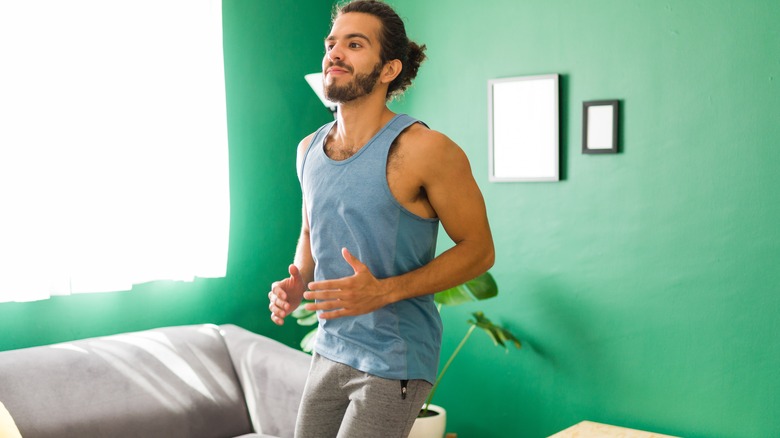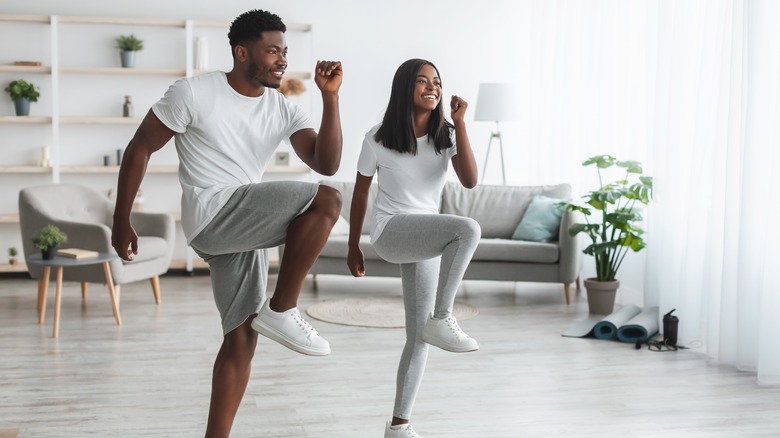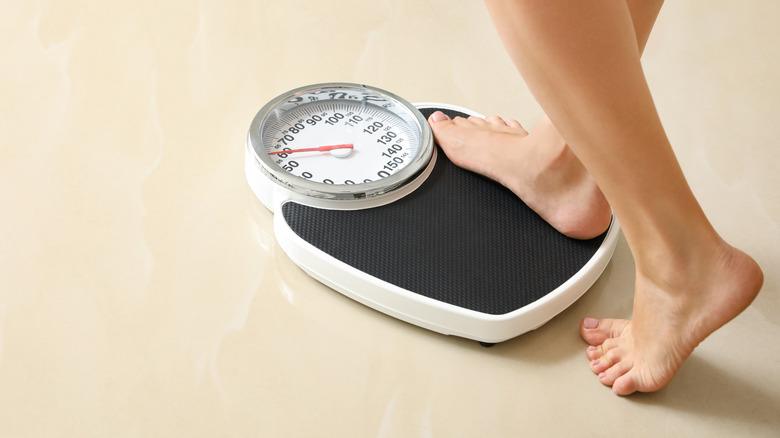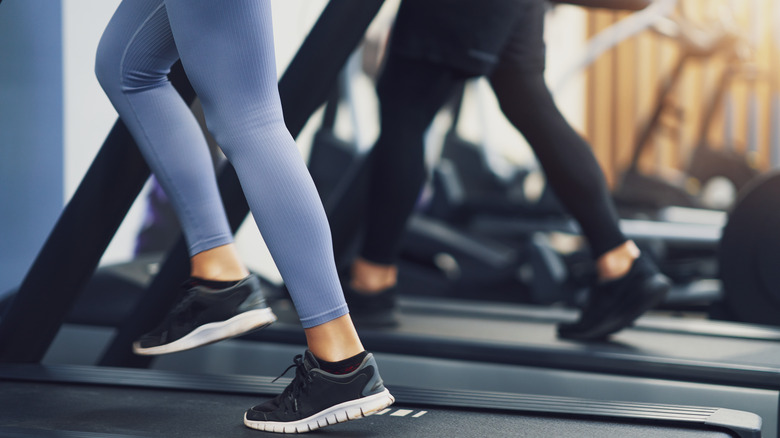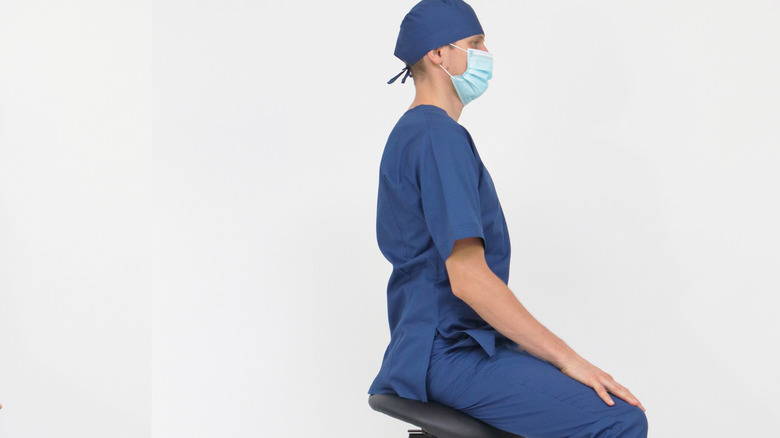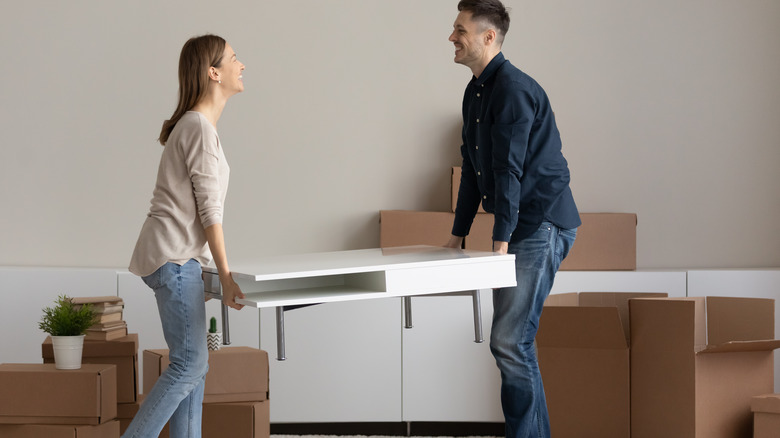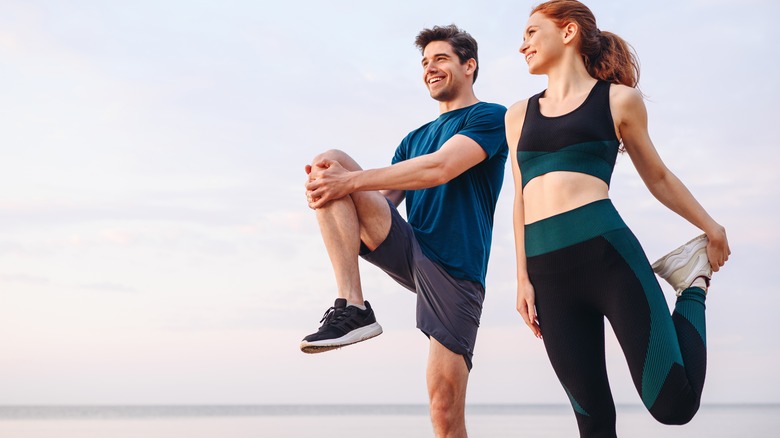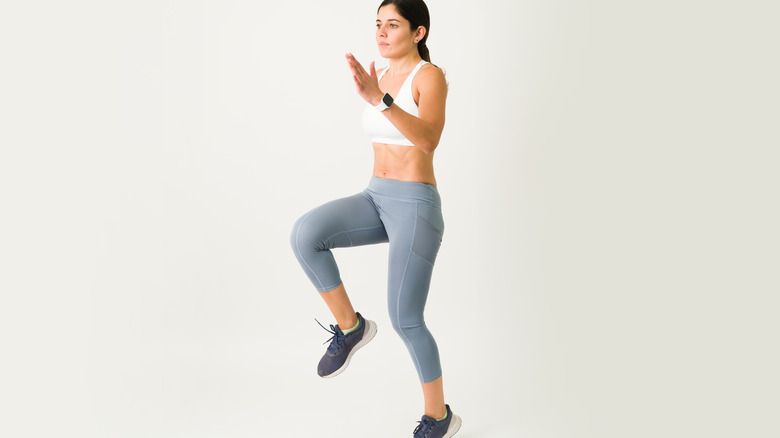Surprising Benefits Of Running In Place
You have probably heard often that exercise is important for your health. But when you factor in work, time with family, maintaining a household, and squeezing in some fun, what time is left for working out? (Or what money is left for a gym membership?) If you aren't getting enough exercise, you're not alone. The Centers for Disease Control and Prevention (CDC) report that about 50% of American adults don't get enough aerobic exercise, which is defined as physical movement of your body that increases your heart rate (via National Cancer Institute).
For some people, living in a community that isn't designed to accommodate foot and bicycle traffic is a barrier to exercise (via CDC). Time is also a key factor for many folks: One study published in the journal Sports found that about half of the participants who were inactive reported a lack of time as a reason for not exercising.
Running is an aerobic exercise that can help you build strength and endurance in addition to burning calories (via Better Health Channel). But if you find it difficult to get in a run because time is short, or you don't have sidewalks or a safe path in your neighborhood, running in place can be a good option. Not only does running in place yield many of the same benefits as regular running, but it offers some surprising perks as well.
Save money and do it anywhere, anytime
If you're prioritizing your finances, you may not want a chunk of your income to go to a personal trainer, gym membership, or expensive workout equipment. Indeed, in one survey of 282 young men published in the American Journal of Men's Health, around 33% of respondents reported the cost of facilities as a major barrier between them and exercise. According to Healthline, a gym membership will cost you about $58 per month in the U.S., but it's likely to be even more in higher cost-of-living areas. As of this writing, this is an expense that many Americans might want to forego: The 2020 census found a statistically significant decline in median household income in the U.S., the first since 2011.
However, the CDC notes that running — which doesn't require special facilities or expensive equipment — is a good exercise to pursue if the cost of a gym membership doesn't fall within your budget. And running in place doesn't demand much space — so it's an activity you can do within your own home or yard, at no cost (via Healthline). Moreover, on long workdays, you can run in place in your office. You might also think about finding an exercise buddy at work — a small study published in The Scientific World Journal, many participants reported that they were more likely to exercise if they could do so with coworkers.
Running in place can help you lose weight and belly fat
You certainly can burn calories by running in place. The Wisconsin Department of Health Services reports that for someone who weighs 155 pounds, running in place for one hour can burn about 560 calories. This would be about 280 calories in 30 minutes, and about 140 calories in 15 minutes. And because running in place is so accessible, if you can't spare a full hour at once, you could do a few 15-minute sessions throughout your day.
The key to weight loss is to burn more calories than you eat, as stated by the Mayo Clinic. Therefore, if you want to lose weight, running in place can help. But will running help you tackle fat in a particular part of your body, such as your tummy? Well, yes and no. "Spot reduction" — the idea that an exercise will cause fat loss in a specific area of your body — is a myth, according to Healthline. Rather, overall fat reduction in the body can help you get rid of belly fat, and running can help with this aim. Indeed, one small study published in Medicine and Science in Sports and Exercise found that regular running led to a significant reduction in belly fat among the participants, as compared to those who either did not exercise or engaged in walking. The researchers suggest that it is high-intensity exercise in general, like running, versus none or low-intensity exercise like walking that is likely to burn more fat and calories overall.
It accommodates any fitness level
One way in which running in place is very versatile is that you can do it no matter what your fitness level is. As Origym explains, if you are new to running or running in place, you can start by running slowly for a shorter duration, like 15 minutes. Then the next time, do it for 20 minutes, and so on. If you need more of a challenge, you can include intervals while you're running in place. For instance, alternate between running at a faster pace for 30 seconds and your normal pace for 15 seconds.
People who are at a higher fitness level or who want a more varied routine can incorporate running in place into a high-intensity interval training (HIIT) workout. HIIT, as explained by the American College of Sports Medicine (ACSM), is a workout where you do short periods of high-intensity exercise alternated with periods of rest or low-intensity exercise. Origym suggests how to include running in place in your HIIT workout: Run on the spot as fast as you can for 30 seconds, and then have a recovery period of 15 seconds during which you jog slowly. You can keep a clock with a second hand in front of you to keep track of your intervals. According to the ACSM, HIIT gives you the benefits of exercise in shorter periods of time. This is because you tend to burn more calories with HIIT compared to steady endurance workouts.
Running in place may improve posture
In addition to burning calories, running in place might also help improve your posture. A small study in the Journal of Physical Therapy Science suggests that drawing your abdominal muscles in tight while you run in place can improve multiple postural markers including trunk inclination and imbalance, and pelvic position, torsion, and rotation. It's important not to move or wobble too much during this exercise, however. In order to help keep yourself in place, you can use masking tape to mark a 12-inch by 12-inch square space and be sure to keep your movement within that zone.
One variation of running in place that can also help improve posture is high knees. This is because high knees engages your core muscles, as explained in an article on Marathon Handbook. This helps to keep your torso straight up and prevent slouching. To run in place with high knees, run with your feet shoulder-width apart, tighten your core, and try to get your knees up as high as you can.
Your lumbar stability might improve
When you have lumbar stability, as explained by an study in the Journal of Physical Therapy Science, you are able to move into different positions while keeping the vertebrae of your spine properly aligned. Physical therapist Eric L'Italien told Harvard Health Publishing that a stable spine is more flexible and can support a larger range of movement. This would make it easier, for example, to go from carrying in groceries to chasing your toddler around the house. Spine instability, on the other hand, can cause lower back pain or injury. In turn, this can lead to decreased movement overall as someone tries to avoid provoking painful episodes.
What helps to stabilize your spine is having strong core muscles, according to L'Italien. And as researchers discovered in a small study, running in place while drawing in your core can lead to meaningful increases in dynamic (moving) lumbar stability (via Journal of Physical Therapy Science).
Strengthen knees by running in place
It is commonly thought that running can exacerbate wear and tear on the knees (per Harvard Health Publishing). However, David Felson of the Boston University School of Medicine told NPR that research has found that running doesn't increase the risk for knee arthritis. What's more, Felson said that one study found that the knee cartilage of runners was stronger compared to the knee cartilage of those who did not exercise. So, running might actually be good for your knees.
Jonathan Chang, an orthopedic surgeon, also told NPR that running might stimulate the cartilage in the knee such that it becomes stronger, similar to how muscles grow and get stronger with exercise. Furthermore, researchers are finding that some cartilage loss naturally occurs as part of the aging process, so it is likely that the loss is not so much related to jogging as it is time. At the same time, Nancy Lane, director of the UC Davis Center for Healthy Aging, told NPR that if you have had a knee injury, running could increase your risk for knee arthritis. Other factors that increase the risk for knee arthritis include running really fast on a routine basis and running a marathon. Therefore, Lane recommends running in moderation — about a 10-minute mile pace for around 40 minutes per day.
It can keep your bones strong
It's not just calcium that your bones need — they need exercise too. According to the National Institutes of Health (NIH), bone, like muscle, is living tissue and becomes stronger with exercise. But how exactly do you exercise bone? Well, you do this by doing physical activity that is weight-bearing. This means, according to the NIH, that your body is working against gravity. While exercises like swimming and bicycling are great for heart health and building muscle strength, your body isn't working against gravity in those cases. Examples of weight-bearing exercises include dancing, playing tennis, hiking, lifting weights, and yes, running or running in place (via Bone Health & Osteoporosis Foundation). The Surgeon General recommends at least 30 minutes of daily weight-bearing exercise (per NIH). So while watching your favorite TV show, instead of riding your stationary bike, consider running in place to help keep your bones strong.
Running in place may improve walking stability
You probably don't even think about walking, since it is automatic. The average American walks about 1.5-2 miles per day even without trying to exercise (per the Mayo Clinic) — trips to your car and the bathroom add up. And when it comes to your musculoskeletal health, having a symmetrical walking gait is important so that you put an equal amount of stress on both sides of the body. Asymmetry in the way you walk can cause pain and other issues, according to the Handbook of Human Motion.
One small study in the Journal of Physical Therapy Science suggests that a running-in-place exercise routine can improve the stability of your gait. The researchers explain that running in place activates the muscles around your hip joints, and these muscles play a large role in having control while walking. The researchers also add that drawing in your abs while you run helps to strengthen and stabilize your core. This can help you to have a symmetrical gait as well.
Your balance may improve if you run in place
It goes without saying that good balance is important in reducing the risk of falls and related injuries (via CORE Physical Therapy). And it is not just older adults who are at risk for fall-related injuries. For instance, a study in the PloS One journal found that almost one-third of middle-aged men and almost half of middle-aged women have sustained fall-related injuries. Among 18- to 44-year-olds, about 20% of men and 40% of women have hurt themselves by tripping or falling.
According to Origym, good balance means that various muscle groups work together to keep you in a firm position. Running in place involves alternating your leg movement with your arm movement, which helps you maintain balance as you run. Origym claims that by running in place on a regular basis, your body will get used to these positions that give you balance. That way, when you walk from your car to your front door, or up or down your stairs, you are more likely to do so in a balanced position even though you may not be conscious of it.
How to run in place
According to the U.S. News & World Report, exercising with proper form can help you reduce the risk of injury and get the most out of the exercise. When it comes to running in place, Origym explains that proper form involves keeping a slight bend in your knees and having your legs hip-width apart. Stand tall and look straight ahead. Start by raising one leg and swing the opposite arm forward at the same time, and make sure that your elbow stays close to your body. Then, with a slight bounce, switch to your other leg and arm. Repeat these alterations until the motion mimics running. Also, be sure to push off and land on the balls of your feet as recommended by Bretta Riches who is a runner and Masters of Science candidate in biomechanics.
There are variations of running in place that you can add to your workout to avoid monotony. One way is to do butt kicks where your thighs stay perpendicular to the floor and you move your calves behind you, as though you are trying to kick your butt. Another is high knees, where you bring your calves in front of you and try to get your knees up as high as you can.

